Next, we look at how different elements of these can be combined in a Neapolitan suit – along with some idiosyncratic elements.
It is a cashmere-donegal jacket from Rubinacci, and is something of an outlier among all the pieces I have had made bespoke in Naples.
(As with all pieces in the series, the jacket was made bespoke in a standard house style – enabling us to compare how different bespoke tailors cut to one consistent body shape.)
House: Sartoria Rubinacci
Address: 96 Mount Street, London
Site: www.marianorubinacci.net
Cutter: Andrea
Price (at time of writing): £4650 (incl VAT, vintage cashmere)
Suit starting price: £4900 (incl VAT)
The jacket was made in 2011 – the first piece I ever had made by a non-English tailor.
Rubinacci had recently established their shop on Mount Street, and were the only high-profile Neapolitan available for men in London.
They caused something of a fuss, with writers like Nick Foulkes becoming a big client, and The Rake covering the visits of Luca or Mariano Rubinacci consistently.
I was eager to try the Neapolitan style too, and commissioned a jacket in a vintage cashmere cloth that Mariano had in the shop. It is a lovely mid-brown, woven in a donegal flecked style.
I was measured by Mariano but travelled to Naples for my second fitting, following the advice of another customer who had had a poor experience just being fitted in London.
Fortunately, following this path my jacket turned out well, and it’s still something I wear regularly.
However, as alluded to in the introduction, the style is not what you might expect.
The most obvious point is the lapel. Every other Neapolitan tailor I have used has a straight lapel, actually looking a little concave as it bends into the waist button.
But the Rubinacci lapel is curved outwards. It has what a tailor would call ‘belly’.
This is a shape more normally seen on English suits (and, given how many suits are now made in an Italian style around the world, makes them look distinctive or antiquated, depending on your point of view).
The Rubinacci lapel is actually more curved than the English, as they tend to be slightly rounded at the waist button, and then straighten as they approach the collar.
(In this series, the Huntsman jacket is a particularly good example, with Anderson & Sheppard having a more moderate version.)
Now, not every Rubinacci jacket has this style of lapel. Luca Rubinacci’s style exploits in particular mean his house varies more than most others.
It’s also noticeable that Luca used to have this lapel on his jackets more in the past than today.
But a customer should still be aware that this belly style might be the default – as it was for me – and that the variation means you have perhaps more choice than elsewhere.
Most tailors will make a lapel wider or narrower, but rarely want to change the shape entirely. (I’d also always recommend that customer don’t ask them to do so – stick to what the cutter knows.)
This Rubinacci jacket is abnormal in other areas too.
It uses the English-standard three layers of structure in the chest, including one layer of horsehair, where other Neapolitans use fewer and lighter layers.
Its shoulder padding is made up of three layers of wadding, which is not as much as the English, but still more than most Neapolitans.
And most unusual of all, it adds a small piece of wadding right at the end of my shoulder, to lift it up slightly as it approaches the sleeve.
Now as I have sloping shoulders, most tailors outside Naples will want to do something to compensate.
The English often add more padding; the French emphasise the roped sleevehead; the Milanese tailors and 1960s-influenced tailors like Edward Sexton or Chittleborough & Morgan add padding at the end of the shoulder – like this Rubinacci.
But my Rubinacci jacket is the only one to have a relatively lightly padded shoulder, and then add that kick at the end.
The effect is subtle on this jacket, because once there’s been that kick, the shoulder runs into the top of the sleeve very naturally.
The sleevehead there has no wadding whatever, making the cloth simply fall off the end of the shoulder. (And emphasising the ripples of cloth at the top of the sleeve.)
A final point of difference is the fronts (the line of either side of the jacket below the waist button).
These are quite closed relative to other Neapolitans, and again more similar to the English. Even the way they curve at the bottom is more anglicised.
Elsewhere, the shoulders themselves are quite narrow (5⅞ inches) but don’t really appear so given those wide, curving lapels and kick to the shoulder padding.
The sleeve is fairly generous for a Neapolitan tailor, although tapered towards the cuff.
And the jacket is quite fitted through the lower back, running closer to the body than many.
In fact that, the softness of the cloth, and being only half-lined are probably the biggest causes of the jacket looks a little short in the back, not fully covering the seat.
Style-wise, the jacket also has a few idiosyncrasies.
One of these is the curved hip pockets (shown above), which were something Mariano suggested to me at the time and I was happy to try.
His version of an English hacking pocket, they are unusual (I’ve only had it elsewhere from Timothy Everest) but over time I found I disliked them – particularly as the curved flaps are a little deep (2½ inches, where most would be 2¼).
As a result, I usually keep the flaps tucked in.
A last point is the sleeves, which we kept unlined.
This can be a nice thing on a summer jacket that you want as cool as possible, but only where the cloth is smooth and has less friction (eg cotton).
It’s a bad idea on a wool or cashmere. It’s a pain getting your arms in and out, and there is little benefit in coolness.
The other pieces I’m wearing with this jacket are: cream corduroy trousers from Pommella, a white linen handkerchief from Anderson & Sheppard, and my light-grey Friday Polo.
Grey is the one colour of Friday Polo with decent stock at the moment – although even there we have no mediums left.
The shoes are Belgravias from Edward Green – a loafer that fits me surprisingly well (the 184 last) given my narrow heels.
Style breakdown
- Shoulder width: 5⅞ inches
- Shoulder padding: Moderate to light
- Sleevehead: No roping or wadding
- Sleeve: Moderate, tapered cuff
- Cuff width: 11 inches
- Lapel: 4 inches, curved
- Gorge height: 3⅞ inches
- Drape: None
- Outbreast pocket height: 10⅜ inches
- Buttoning point: 18½ inches from neck point
- Waist suppression: Slim
- Quarters: Quite closed
- Length: 30½ inches
- Back seam: Suppressed
- Vent height: 10¼ inches
- Trouser width at knee (not from Rubinacci): 19½ inches
- Trouser width at cuff: 17 inches
You can read more on the process of ordering the Rubinacci jacket in these old posts (I used to write more but much shorter posts back then!):
- 1: Cloth
- 2: Style
- 3: Measuring
- 4: First fitting
- 5: Second fitting, Naples
- 6: Finished suit
Photography: Jamie Ferguson @jkf_man
What to learn about how Permanent Style is funded? Read here: ‘Is this an ad?’


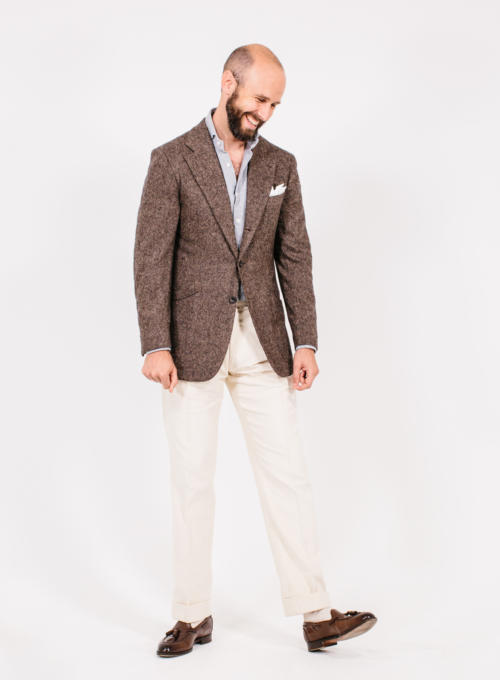
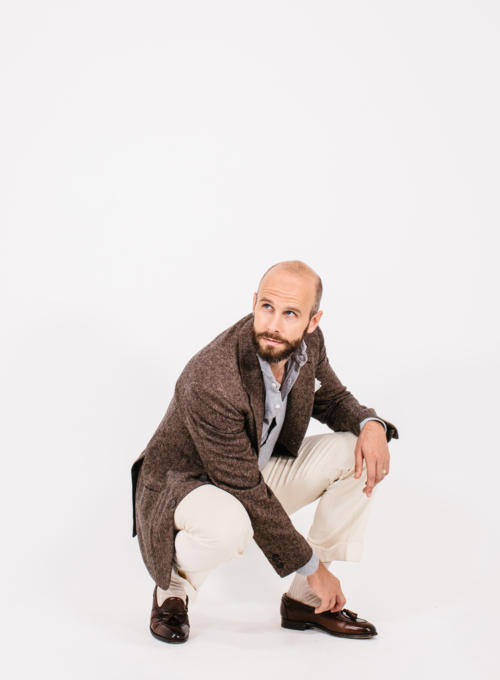
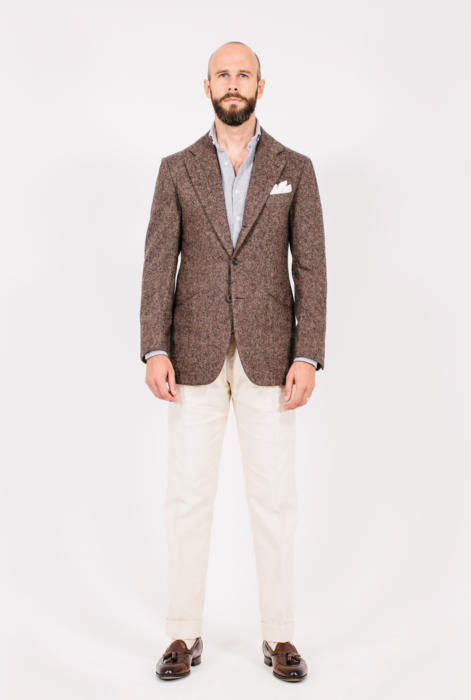
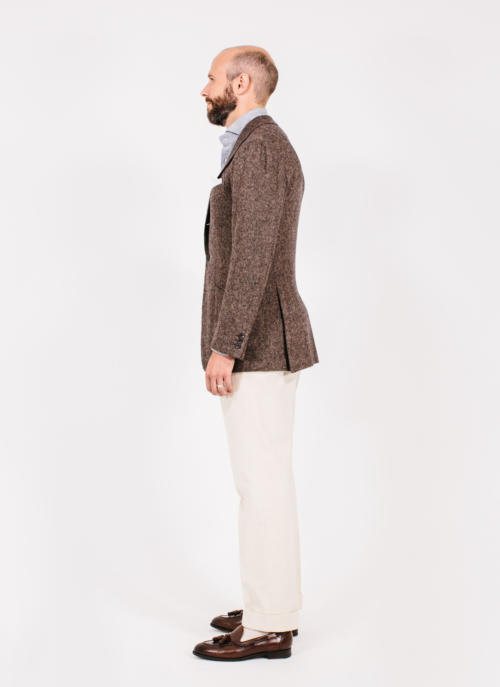
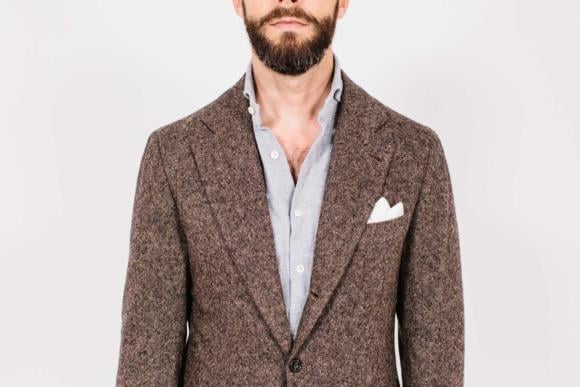
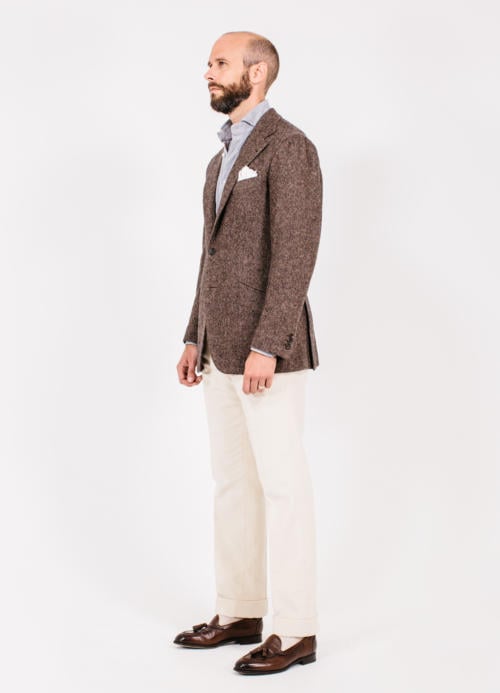
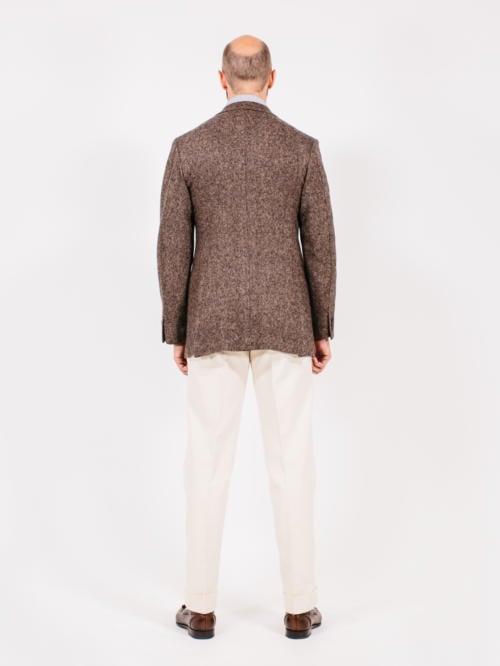
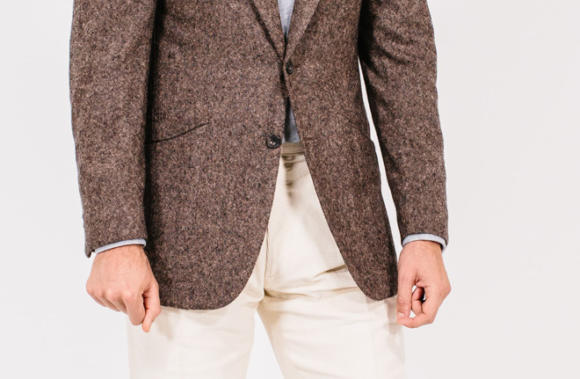
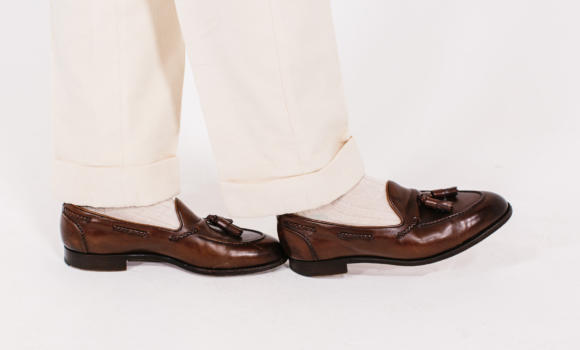
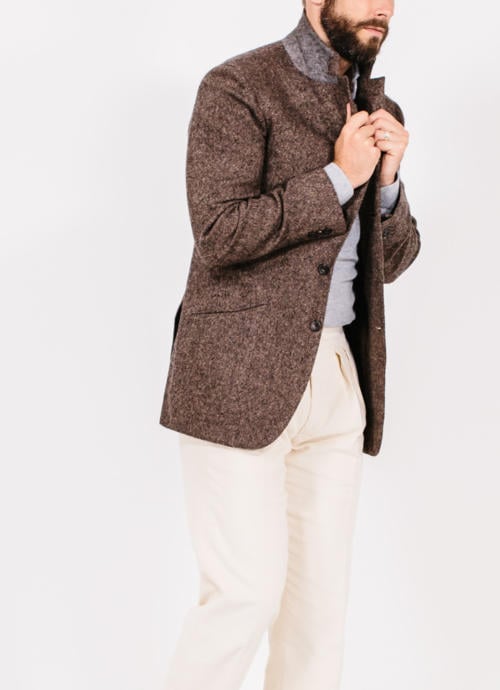


























Simon
Nice jacket but very pricey.
You mention that the sleeves are unlined. I’m commissioning a linen suit for a summer wedding in Portugal. The thought of having the trousers unlined and the jacket unlined quite appeals to me. What are your thoughts/experiences with no lining? Obviously , I’d hand to line the front of the jacket.
No lining is worth doing on a summer piece like that. Small downsides that it might be more fragile, but that’s about it. I’d still probably line the sleeves though – you don’t lose much heat through there compared to the back for example.
Yes, Rubinacci is expensive. The biggest ‘name’ or brand among Neapolitans
I would always go for a buggy lining on a linen coat. Happy to go with unlined trousers and I wouldn’t bother to line the sleeves.
Simon, Anon
Thanks for the replies. Unlined trousers it is. Simon, would you bother to line the back of the linen jacket? Also, why would it be more fragile if I skip the lining? Also, any particular reason why you’d line the sleeves?
The top of the back (so a buggy lining, or half lining) I would line, yes. Because it’s so much more comfortable to put on and wear.
The jacket can be more fragile because it doesn’t have the support of the lining.
I’d line the sleeves because again they can be a bugger to get on and off, and that’s not where the benefit of heat escaping is likely to be.
Thank you very much for clarifying. Much appreciated. Trousers are fine unlined though?
Yes
What’s with all that vanity?
With the money you pay in UK you can easily go to Napoli spend a weekend and buy three jacket same quality,maybe the same one.
There is no such a thing as the biggest brand or name in Napoli,there is just if you are in big ten and they are all as good as it can get. And there is next ten as good as the previous one.
Cheers
Hi Simon,
If I recall, in previous installments of this series you mentioned that you worked with a cutter to analyze all suits and jackets. Do you know what his impression of the finishing of this jacket was, or do you have any thoughts on the finishing of Rubinacci compared to other Neapolitans?
Thanks
Yes, we worked together on all of these pieces.
The finishing is solid. As good as the best Neapolitans, but that means not at the same level as the French or most English tailors
are you sure the knee measure is 29.5″?
Nope, should be 19.5. Thanks for the correction
Simon, would you please explain what finishing is exactly and its importance, or lack of, in the construction of the suit.
Sure Scott. By finishing, people mean the sewing on the outside of the suit that you can see – rather than the construction inside, like the padding of the lapel, or the way panels are sewn together.
That includes hand-sewn buttonholes on the outside of the jacket, and perhaps prick stitching along the edges, but also the way the lining is attached on the inside and the way to pockets are cut into the lining (or not).
It’s mostly just aesthetic, rather than making a functional difference to the jacket. And the best is normally finer and more consistent – so more stitches to the inch, cleaner stitching – and details like a Milanese buttonhole or decorative stitching.
Thank you! That’s what I thought, but this clarification is very helpful. So, in your opinion the English tailors do a better job of finishing, in general, then the Italians?
On average yes, though the bigger difference is probably between southern Italy and northern. Caraceni is very good.
But the French are the best.
Hear hear. Count on having your buttons re-attached within a couple of months with the Napolitans
Buttons coming off varies a lot between Neapolitan houses in my experience. Has happened with Solito, Eduardo De Simone, Dalcuore. But not Ciardi, Rubinacci, Zizolfi, Caliendo etc
Dear Simon
May I make an observation? I think you would benefit greatly from having your jackets increased in length by a good 1/2″, maybe a touch more.
Having looked at many of your articles, it always seems they are too short for your body shape. For example, looking from the side, they emphasise your hollow back and protruding backside. Cut longer, the top of the vents would start that much lower (whilst remaining the same length overall) and give a smoother line running down to the hem.
By the same token, the view from the back would drop a little and more effectively cover your bottom.
From the front, they mostly seem to stop slightly above or in line with the bottom of your fly and again a tad longer would overcome this. It would have the advantage also of allowing the button stance to drop lower, elongating your torso, giving you a bit more swell in the chest and taking the eye away from your sloping shoulders.
The only jacket l see on you which fairly reflects your shape and proportions in the Sexton DB which looks perfect.
Just my thoughts.
Of course David, a good observation and well received.
I think there are two aspects to this – one technical and one stylistic.
I agree that a longer jacket would cover my seat more, and across the series you can see that from several other makers, particularly the English ones. (Although I actually find a higher vent helps deal with the seat, rather than a lower one.) The issue with the lower back is easier to control – more or less suppression there deals with that I find.
From the front, the angle of the opening probably makes a bigger difference than the length – a Neapolitan with a large, rounded cutaway will seem much more exposed. And on the button stance, one of the interesting things in comparing jackets in this series is that actually the waist button can vary considerably in height, whatever the length. So I think that could be raise or lowered without changing the length if I wanted.
The other point is style. Longer jackets just look smarter and more formal. I have had softly made jackets that are longer, and they just look too smart, certainly for jeans or chinos. So if you want a jacket that works with a much more casual outfit, then you sometimes have to compromise on what would be a better technical length.
Thanks again for the opportunity to talk about this.
Thanks Simon
I am 5’11” and have my coats made at 31″ with the button at 19.5″. My chest is around 43″ and waist 35″. I have my vents cut at 10″. Same measures for formal. informal, heavy tweed or fresco. Just seems to work and makes life very easy indeed for my tailor (who has made a few suits for you).
Hi Simon
Why do you measure jacket length from the back and not the front? Does this jacket have the same length across front and back and have you experienced this differently at different tailors?
My tailor tends to keep the front of the jacket longer than the back.
We measure the back because we’re not at the detail level of doing back and front, and back is a lot easier because you have a hem at the bottom to measure to – which you don’t at the front unless it’s a single breasted.
Yes, different tailors do vary as to how much they slope back to front. Most English tailors don’t slope much (see here) but southern Italians tend to more.
I think if you browse the articles in this series, and look at the side profiles, you can see that illustrated.
One further question please….how high would the patch pockets be placed on a jacket? i.e. the gap between the bottom of the pocket and the bottom of the jacket. Also, have you noticed this being done at different heights by different tailors?
I can’t really tell from the pictures but considering that the pockets have flaps, I assume these aren’t patch pockets.
They aren’t, no.
One rule of thumb with patch pocket height is for the top of the pocket to be level with the lower button on the jacket. This usually looks good. But obviously that can change as the jacket itself gets longer (with different heights of customer), the placement of the buttons changes just due to style, and some tailors just make pockets bigger than others.
As long as the pocket looks in a natural place, and you can get your hand into in naturally, that’s the main thing.
Hi Simon – with your measurement of the length of the jacket what point do you start from at the top? And might you be able to disclose how tall you are?
I’m 6 foot tall, and the length is the length of the back seam – from where it meets the collar to the bottom edge
Will you be doing an overview of your Vergallo pieces? It would be good to have a comparison of northern Italian vs southern Italian.
Vergallo isn’t that representative really – I’d compare this to my Caraceni that we’ve already done
Simon
As an idea, you’ve covered guides to tailoring styles, how about some of the more technical points? So , suit lining, turn-ups, buttons, pleats etc. You’ve covered these points before. However, a guide in the same vein as your fabric guides would be good. Thoughts?
Yes, nice idea. So a series providing deeper information on each of those in turn?
Yep. Exactly. I bet if you go through the comments, there will be a lot of questions covering these topics. Having a guide section would also allow readers to post and lookup in a single place.
Thanks, I’ll plan something
Given that you’re talking about a bespoke jacket, is it correct to say that the style is Luca Rubinacci’s? He is neither the cutter nor the tailor.
Hi Simon,
Jacket looks great.
Is there somewhere on the site you can point me that explains the difference between, full canvas, half canvas, floating canvas etc.?
There’s a little bit on it in the guide to quality in a suit
But basically, a jacket has a canvas to give it shape. It can run half way down the body or the full way. Most good suits run all the way; there’s a small argument you might want only halfway in a cheaper or lightweight jacket.
And that canvas can be sewn to the outside or glued. Sewn means ‘floating’, glued is called ‘fused’.
– Great post; so far Rubinacci essentially meant wide lapeled DB to me. Here it seems there is extensive British influence, both in the construction and the style.
– Do you see a substantial difference of comfort with the traditional Neapolitan and English constructions, especially on the shoulder and breast. Is it similar to french or Roman jackets in that aspect?
– wondering whether you spoted a tailor making English/french style casual jackets with a very soft (Neapolitan like) construction?
– I also dislike hip pockets bent that way.
I’m not sure what you mean exactly on your second question, but I certainly notice a comfort difference between Neapolitans and English – but not between Neapolitans and this Rubinacci.
No, I haven’t seen a tailor make in that style. Among old bespoke tailors the make and style usually come as one. You see mixes more in new markets or tailors, eg in Japan.
I like the way the colour of the socks continues the trouser line to the shoes. A very elegant look. I have always thought patterned or brightly coloured socks as jarring.
Nice point. Generally in classic menswear the default is to match the socks to the trousers, the theory being that it lengthens the appearance of the leg. Coloured socks or even patterns can be nice too of course, but often sock manufacturers in particular go over the top. It’s not subtle and therefore often looks cheap.
Brightly coloured socks are fine, but beware of the context. Not really law or finance, but in the right place a canary yellow sock with a navy flannel and snuff suede shoe can really sing. Cardinal red against charcoal equally so.
If patterned, it has to be oh so subtle. The Simpsons were made for TV, not socks.
Length aside, I like the silhouette of this jacket. The strong shoulders suit you well without being roped, a feature I generally dislike.
My primary issue with the piece, though, is its connotative incongruity. The texture of the fabric is rough and earthy, which seems to call for tweed rather than cashmere. The length, hacking pockets and, again, texture of the fabric make the jacket decidedly low-key and casual, but the bold, sweeping lapels suggest drama. Given the heaviness and softness of the fabric, finally, the horsehair interlining seems unnecessary. All of this is made more vivid with a comparison to your Caliendo tweed, one of my favorite commissions of yours.
Nice ensemble with a subtle colour palette. This could be worn in so many scenarios. The jacket is nicely balanced. Thanks for giving detail to the slight kick in the shoulders – it’s very subtle. Strangely, what I really like is the shoes! They make the outfit. Not sure if we have seen much of these before (EGs) has there been a piece on them?
No, the Belgravias are some of my favourites, but I’ve never really covered them in detail
Interesting. I was thinking that the tasseled loafers are a bit much. I have a really nice pair of Alden cordovans but I struggle to wear them because they always look a bit toppy. I think it works with jeans without socks (in a suitable climate) but difficult to wear with tailored stuff. It’s probably the tassels
Has your preference concerning the trouser length changed over the years? I recently reread an older piece, where you advocated for a slight brake at the front, but it looks like you’ve moved to no break?
I’ve come round to preferring the no break length myself both for dress trousers and chinos as it gives a very clean silhouette and find that it is becoming more popular at the moment?
I can add some perspective based on quite a few Rubinacci suits and sport coats I had made in around 2008-12, mostly in Naples with Mariano, a few initiated in Milan and New York with Luca. I’m still wearing every one of these — they endure; I’ve only had to re-line some of the coats.
Stylistically, it’s not an accident that the firm is called London House. I’ve loved the Neapolitan approach, but restrained, of Rubinacci. None of my lapels is bellied, so I’m not sure why Simon’s experience was different – but perhaps, in true bespoke fashion, there was a good reason (to calm his tall narrowness?). Initially, I wanted spalla camicia shoulders, but was politely ignored because that was wrong for my physique, which I realize in retrospect. I have one coat with the curved side pockets, whose flaps I also keep inside, and I like them for variety. I can’t imagine why coats made from heavy cloth would be unlined in body or sleeves, but all my linen and linen-mix summer coats have minimal body lining and no sleeve lining – I think the latter is especially wonderful because, unlike a coat body, you can’t really open the sleeves for air circulation. A little more difficult to put on and take off, but that just reminds you that there’s a good reason for no sleeve lining. The only style issue I pushed (a bit) was getting the suit trouser widths a bit narrower down to the cuffs. If you like the general Neapolitan approach, I recommend trying to get to Naples, and then follow their advice.
Interested in knowing what about your shoulders made a spalla Camicia inappropriate. Thank you.
Like Simon, my shoulders slope down quite a bit, and my Rubinacci costs correct for this in what appears to be the same way. My impression – which may well be incorrect – is that a spalla camicia would be inconsistent with that approach, or perhaps impossible.
Thanks Michael. A spalla camicia doesn’t actually have anything to do with the line of the shoulders – but I assume you mean a natural unpadded shoulder line, and you’re right this will always make sloped shoulders seem more.sloped
Thank you. Maybe R wanted a strong rope to (visually) lift the shoulder at the end without adding padding to the shoulder. Assuming a spalla camicia is rarely associated with a rope.
I once visited their Mount Street shop and was instantly put off by their appalling lack of service.
They seem to think they are the curators of a shrine to Signore Rubinacci and that anybody who opens the door is an unwelcome interloper into their Italian parlour.
Beyond that, the jacket looks OK apart from the patch pockets cut at a slant which makes the thing look like it’s trying too hard.
Reading this review, I can’t quite decide if you’re happy with the jacket or not! For what it’s worth, I think it looks fantastic; the fabric is a great colour, and I rather like the effect of the closed quarters and the “bellied” lapels. I even quite like the slanted pockets, although I can see how they might be a bit too unusual on an everyday jacket.
The price is eye-watering though. I know you often say margins are fairly consistent among bespoke makers, but it’s hard not to wonder if they’re cashing in a bit on their fame and celebrity patronage here. I can’t imagine the extra cost is going towards design or marketing budgets as with big fashion houses. (Credit to them if they can do it, but let’s be clear what it is!)
Is the price one of the reasons you haven’t commissioned anything else from them? Or is it more to do with style? Also, with all those “English” style points, do you find this works as well with jeans/chinos as other Neapolitan jackets?
I guess it’s not an overall review, just a detailed breakdown of the cut.
Yes, I do find it still works with jeans
Way too expensive for me but what a great jacket – that donegal is probably the best looking fabric for me. Can I ask why you decided to go for unlined sleeves at the time? The cashmere would be for the colder half of the year anyway?
Yes, I think unlined sleeves just seemed like a nice novelty…
Thank you. Do you happen to know who made the fabric? I am mesmerised by that cashmere donegal – spectular
No,.I’m afraid not. It was a vintage piece without a branded selvedge. I’ve seen lots of lightweight wool donegals in similar colours in recent years, but no cashmeres
Touching on your decision to meet in Naples rather than London: do you agree that it is most ideal to be measured and fitted in the tailor’s city of origin for shoes and garments? If so, why?
No, not at all. I think this advice only applies where the person you meet is not the cutter. And even then, only with some houses
I assume if you had the follow up in London and you weren’t happy you would get them to send back to the work shop until you were happy?
Probably, though at some point you sometimes realise it’s just not going to get better
Very nice looking jacket Simon. I think this is third post on a differences amongst Neopolitan jackets. I’m curious which of the three you prefer at this point in your life…and why?
Have you ever considered purchasing/commisioning a soft wool or cashmere shirt jacket?
Not really. It’s something I like in the summer as a jacket alternative, but not so much in colder weather. I did have a Teba that was similar, but found I didn’t wear it
Hi Simon,
I absolutely enjoy your posts and the inspiring pictures. The style breakdown specifically is an awesome read. I have two, rather general questions. First off, is there any personal rule you follow to pick a pair of brown shoes to pair it with a brown sports coat? I always struggle combining these and end up wearing super dark olive suedes. But your outfits always appear so fitting.
Secondly, you mentioned the lining. Whats your take on trouser lining? Wearing OTC socks with flannels can be challenging without serious readjustments to make the pants sits properly after sitting down 🙂 Want to go for a down to the bottom lining next time…
By the way, I like this Rubinacci jacket. Looks very nice!
Appreciate your answer! Keep up your great work!
Hey Max. Thanks.
I try to keep a little contrast between the browns of a jacket and shoe, having one a little darker than the other. But I wouldn’t worry about it too much – trousers and shoes is a much harder one.
Also, it can help if the shoe has some variation in colour, eg with an ‘antiqued’ or polished toe that is darker than the rest, as here. It means that some of the shoe will definitely be different to the jacket.
On linings, I usually have half linings except on summer trousers. I generally don’t have full linings – they’re too annoying. I tried once on some flannels and it felt almost like wearing two pairs. With the riding up issue on the trousers, you probably need a slightly bigger trouser I’m afraid…
Actually I think the style suits you very well. Jackets from other Neapolitan tailors can sometimes look slightly childish while this jacket with the style and the belly suit you very well.
Thanks again Simon!!!
second picture is a man who’s just realised he’s not wearing lace ups. xx
may i respectfully ask, how much are you tall mr. Crompton?
Six foot
Just a technical note… It appears the Ciardi style breakdown is not linked in The Guide to Tailors’ Styles. It goes from #10 Solito to #11 Rubinacci. This Rubinacci post references the Ciardi post as being an earlier entry in this series. Just wanted to let you know, so if it was intended to be in the Tailors’ Styles series, you could add it.
Thanks a lot Ben, really helpful. I’ll fix that now.
Hi Simon,
I was thinking of commissioning a bespoke donegal tweed jacket, but at the top of my head, can’t seem to identify a bunch that’s appropriate for three-season wear. The 15.5 oz cloths offered by W Bill seem a bit of an overkill, so I’m wondering if you’re aware of a selection that between 11-14 oz.
Thanks for your time.
Dan
I haven’t looked in a while, but a lot of the tweed bunches have some sort of lighter or softer donegals in them. Try the Italians in particular – Caccioppoli, Drapers etc
Hi Simon,
Was just re-reading this and wanted to check if I understood what’s going on with this shoulder. My understanding is they’ve taken the type of material that is often used in the sleeve head to give it a bit of curve over the shoulder (opposed to this which falls straight down), and they’ve then added that to the end of the shoulder on top of the pad. Is this essentially custom making a shoulder pad that has a bit of extra thickness right at the end?
Thanks
Hey Jonny,
Ignore the terminology of wadding or padding – they can be used interchangeably. It’s the same stuff as you’d normally pad a shoulder with, but in everything else you’re right, they’ve added a bit more just at the end, to level out the shoulder a bit rather than just make it all higher.
It’s not so unusual, in that people like Sexton will do it to get that pagoda shoulder look. This is just much subtler. And yes, custom pad.
Hey Simon. An idea, not sure if this has been suggested before, would be nice to have measurements that you give in these articles both in inches and cm since you have readers from all around the world. Possible?
Hi Simon,
Thanks, yes I can see how that would be helpful. I guess it’s not normally a high priority given it’s an easy thing to convert yourself, and some people use both fairly interchangeably. But if I have time I’ll try to include it more.
Thanks for the suggestion